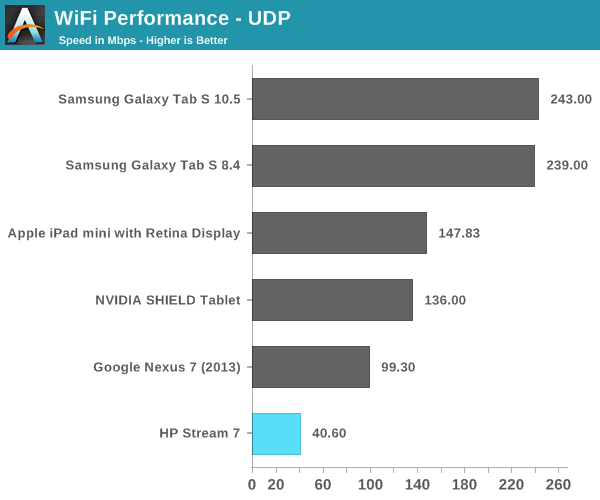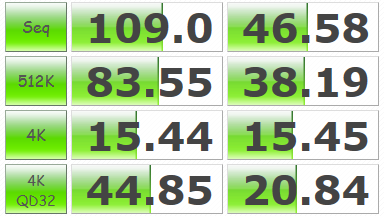HP Stream 7 Review: A $119 Windows Tablet
by Brandon Chester on December 19, 2014 8:00 AM ESTCamera
It looks like including a camera is now a requirement for pretty much any device, and so even the Stream 7 has a front-facing and a rear-facing camera. In the Windows device manager, the front camera identifies itself as "Camera Sensor GC310". I haven't been able to find any information about it, but the image quality leads me to believe that it may be best for people to not know where it came from. The rear camera idenitifes itself as HM2056, which I was able to find information about. It's made by a company called Himax Imaging, and if you haven't heard of them it's okay, because I hadn't either. It's a 2MP 1/5" sensor, which translates to 1.75 micron pixels. It has no auto focus, and that combined with the specifications leads me to believe that this is normally intended to be a front-facing sensor.
As you can see, the output is really bad. The text on the back of the books is illegible, most detail is lost, and there's noise everywhere. It's just honestly not a good camera, and it's something I would only use as a last resort. It's somewhat annoying that HP felt the need to even put a rear camera on the Stream 7, as it adds to the BOM and the money could have been better used on something like a larger battery.
NAND
I mentioned earlier that the Stream 7 doesn't even have enough storage to fit PCMark 8 and some of the other benchmarks we use. Out of the box, you get around 18.5GB free. This means that we can't run our typical Windows storage benchmarks, so I've used CrystalDiskMark to get an idea of how the storage performs.
I wouldn't try making direct comparisons between this and our storage benchmarks on Android and iOS, but it's still able to give you an idea of what you can expect. The Stream 7 uses Samsung's MGB4GC eMMC solution, so we can't expect the same storage performance that you get from Windows devices with a full blown SSD. The read and write performance ends up being pretty good for an eMMC solution, although I'm suspicious of the 4k random write result considering how even the best eMMC solutions we've seen in Android and iOS tablets top out around 3MB/s.
WiFi
The HP Stream 7 uses a Realtek RTL8723BS solution for WiFi and Bluetooth. This is a single spatial stream 802.11n part, with no 5GHz support and only 20MHz channel width. That means that we're dealing with a theoretical maximum speed of 72Mbps. In real world use, it's quite a bit less, as you can see below.

Again, at $119 this is expected and can be excused. Faster WiFi would be nicer, but it's not free. My only complaint about this speed in the real world is that the slow WiFi makes it difficult to move large files over the network onto the Stream 7. This wouldn't be an issue if these Windows tablets allowed you to directly move files to them from another computer over USB, but they don't. I've also encountered issues with the WiFi disconnecting intermittently, which is incredibly frustrating when it means you have to begin transferring a large video from the beginning. I've contacted HP about this to see if they're aware of this issue, as I've seen complaints about it from other users, but I haven't received a response.
Misc
I am unfortunately not equipped to do objective audio testing on the Stream 7. It uses Realtek's audio codec, and so it isn't likely to be anything exceptional. The bottom mono speaker is adequate; there's not much to be said about it. Unfortunately, everything comes crashing down when you try to use the 3.5mm jack. Even if the Stream 7 had the best audio solution in the world, it would be crippled by this defect that I cannot believe made it to production.
Essentially, the 3.5mm jack has a great deal of noise and static, and it makes it effectively unusable. I have confirmed this with two other owners, and there are complaints about it on the web. It's likely that there's an insufficient amount of shielding for the audio port and PCB connections, and it's extremely disappointing. With its support for all the great video players on Windows, the Stream 7 could have been an inexpensive and powerful video player. But unless you're going to use the built-in speaker or Bluetooth headphones/speakers, there's no way to listen to audio on this tablet. When I reached out to HP about the WiFi connection issues I also asked about this, but again I haven't received a response.


















157 Comments
View All Comments
sonicmerlin - Saturday, December 20, 2014 - link
I mean when you open ie metro and then to to settings and change the zoom. It goes up to 400%, but rather than increase text size it just zooms into the page, causing words to end up outside the viewable screen. Then you can't even zoom out. Try going to arstechnica and zoom to 300% (just to see what I'm talking about).The same goes for desktop IE and chrome. On an actual desktop when you go to, for example, chrome's settings and alter the zoom value the font size will increase. But if you do it on a Win 8 tablet it just zooms the whole screen. I've tested this on a win book 7 and an hp stream 7. Heck if you choose "full window" on chrome you can't get out of it without restarting the tablet.
Spectrophobic - Saturday, December 20, 2014 - link
I see what you're talking about. "Zoom" is literally what it suggest, zooming in. It doesn't say it's for font. I think your problem has to do with your vision or 7" is just too small for you. Either play around with DPI settings, get glasses, or opt for a bigger tablet.zodiacfml - Saturday, December 20, 2014 - link
Isn't this futile?Doesn't a 2 in 1 device make more sense than a standalone tablet? Does giving this a keyboard dock would kill netbooks? They should just give up netbooks ang give 7 to 10inch tablets keyboard docks.
ados_cz - Saturday, December 20, 2014 - link
Here in UK I bought similar tablet when it was on sale for £59 (approx. $92) few days ago: Linx 7. I had a chance to hold HP stream in my hand and the bulid quality of Linx 7 is so much better. No creaks, thiner, lighter, micro HDMI out, micro SD slot integrated into the top side. I love the Linx 7, so much bang for buck... Office 365 for one tablet and PC as well. However I too have problem with static noise in headphone output but not as severe as it seems to be with the HP Stream from your description, once a music or anything else is playing, you cannot really hear the stacit noise on Linx 7, battery life ranges from 4-6 hours on Linx and the tablet weights 280g. Great device, almost exactly 20 years ago, I had my first PC - 486 DX2, now I have my first proper Windows 8.1 tablet (Had Acer Iconia before with Win 7) and it is 25x cheaper and so much better :-)) - Here is the Linx homepage http://www.linx-tablets.com/geok1ng - Saturday, December 20, 2014 - link
" the inclusion of only 1GB of memory; that's definitely pushing the limits of what Windows can run on" was said on the first page. but on the rest of the article there is not a single memory related issue reported. So either the reviewer is not aware that windows 8.1 is a memory sapper *highly unlikely* or the above passage should be addressed on the final comments.Spectrophobic - Saturday, December 20, 2014 - link
The memory isn't really a big problems... unless you're using Chrome, Steam, or playing modern games.ados_cz - Saturday, December 20, 2014 - link
I have 1GB of RAM on Linx 7 as well and hard-set the swap file to 2GB and I see no problems. BTW I tried to steam-stream DOTA 2 over my N wireless from mine main PC (i5 4670k + GTX 760) and it works flawlessly and looks great.eriri-el - Saturday, December 20, 2014 - link
A small disappointment I have with this article; I have a Stream 7, and you can enable 20/40 MHz channel width in Device Manager under the Network Adapters, RTL8723BS properties, Advanced Tab, Bandwidth. I can connect at 150Mbps to my wireless network just fine, but I don't notice it being much faster. Not user friendly, but then again this is Anandtech. Also, the article didn't mention a small niggle I have with the display besides what is already mentioned, the screen refreshes at 53Hz only. Not really a deal breaker considering nothing much can go above that refresh rate which entry-level specs, but it's worth noting. Also may I ask Brandon, since you did mention that the average user who probably buys this tablet probably won't have access to this kind of color calibration, can you upload your ICC profile so that we average users can benefit. I know no two screens are exactly the same, but at least it'll be better that what we get out of the box, no?Brandon Chester - Saturday, December 20, 2014 - link
I had considered doing so but I don't know if it might violate some agreement between us and X-Rite or SpectraCal who provided the equipment and software.Brandon Chester - Saturday, December 20, 2014 - link
Also mine is selected to run at 60Hz and UFOTest confirmed that it was refreshing properly.